S Line Nose Augmentation is becoming the preferred aesthetic trend thanks to the ability to create a natural-looking nose that harmonizes with facial features. To further understand the S Line Nose Lift procedure alongside essential notices before and after surgery, let’s have a look at the important information in the following article.
I. What is Nose Augmentation (Rhinoplasty)?
Nose Augmentation or Rhinoplasty is a cosmetic procedure to adjust the height, shape, and size of the nose, and helps optimize flaws to create a harmony within the face. In addition, nose job surgery can also enhance respiratory issues, and fix congenital defects or trauma caused by injuries.
Most Asian have low noses and rather large tips. For that reason, the S-shaped nose augmentation method is usually preferred. Rhinoplasty surgery for Asians is significantly different compared to the one for Caucasians. The noses of Asians often have less distinct features and a lower projection compared to Westerners.
This is because the nose skin of Asians is usually thicker, while the bone and cartilage have a low structure and are weaker compared to the Caucasians. The tip of Asians is also lower compared to the line of Westerners.
S Line Korean Nose Augmentation was successfully applied in Vietnam by Dr. Chiem Quoc Thai in 2008. Currently the best and most good looking rhinoplasty procedure. Viet My Plastic Surgery Hospital is proudly the reputable and trustworthy S-Line Korean Nose Augmentation location for many beauties, helping them become more beautiful and successful. Due to the public scrutiny of cosmetic surgery, many still prefer to keep it private
However, some still agreed to publicize their cosmetic procedure such as: Miss Earth Phuong Khanh, Miss Le Hoang Phuong, Miss Ky Duyen, Miss Huong Giang, Miss Kim Ngoc, Runner-up Hanh Nguyen, Runner-up Kieu Loan, Runner-up Miss International Queen Tuong San, Angela Phuong Trinh, Runner-up Khanh Phuong, Runner-up Bao Nhu, Singer Chi Pu, Actress Yaya Truong Nhi, Actress Lily Luta, Miss Vietnam World Australia Jolie Nguyen, Runner-up Linh Chi, Miss Bikini Kim Yen, Accessories Queen My Duyen, Runner-up Cao Thuy Trang, Singer Thai Tuyet Tram, Model Vu Ngoc anh, Ngan 98, Singer Luong Bang Quang,...
Photos of celebs who underwent rhinoplasty at Viet My Plastic Surgery Hospital
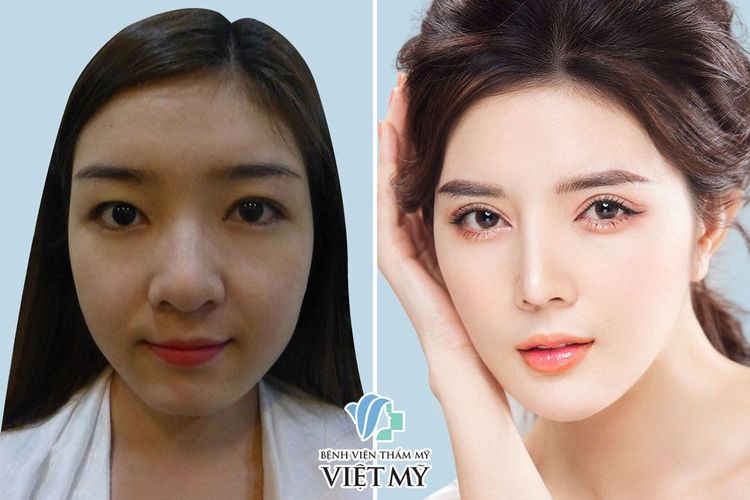
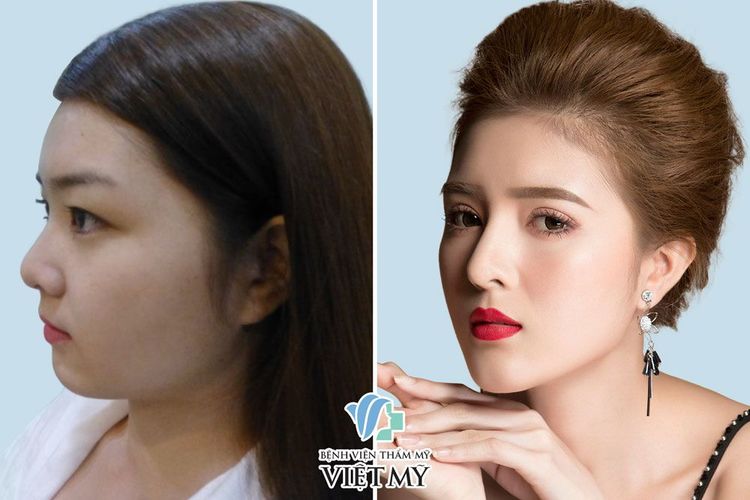

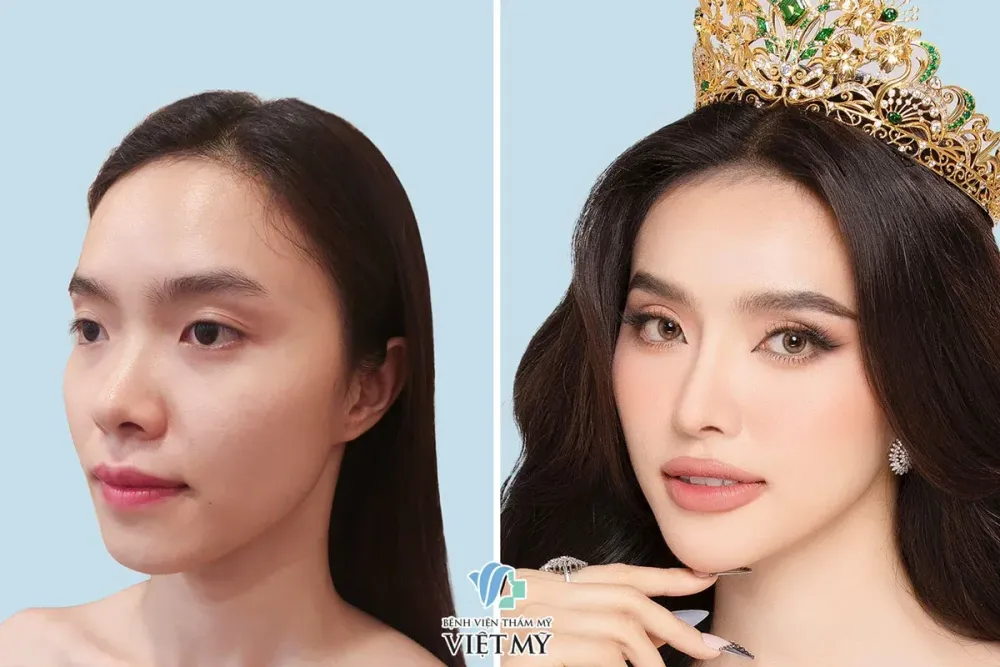

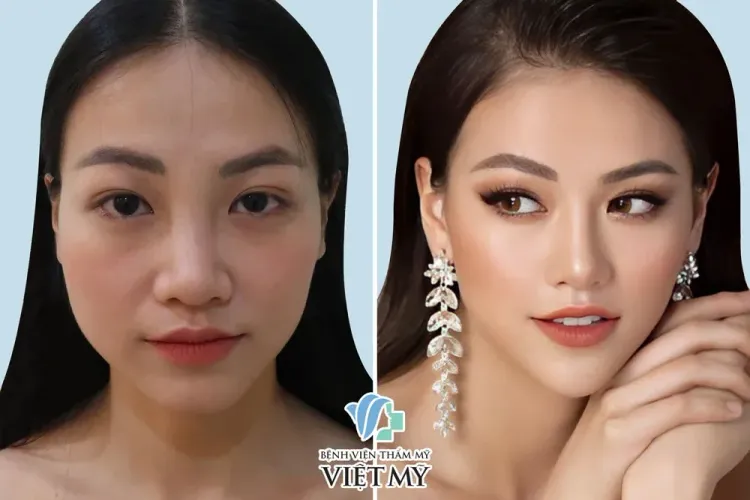
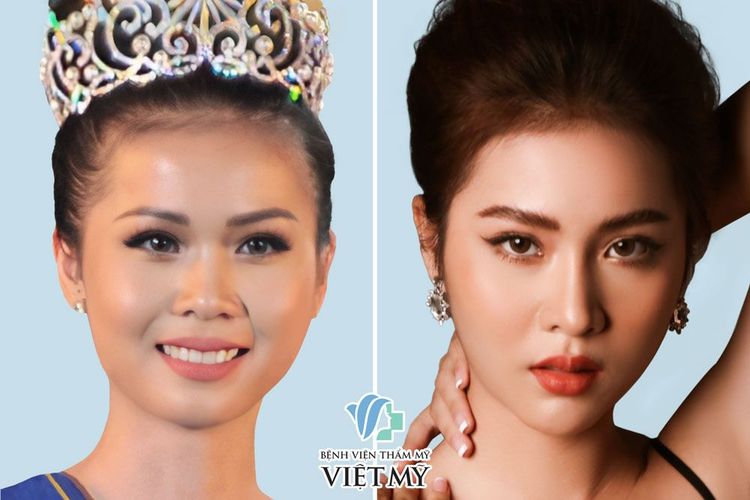
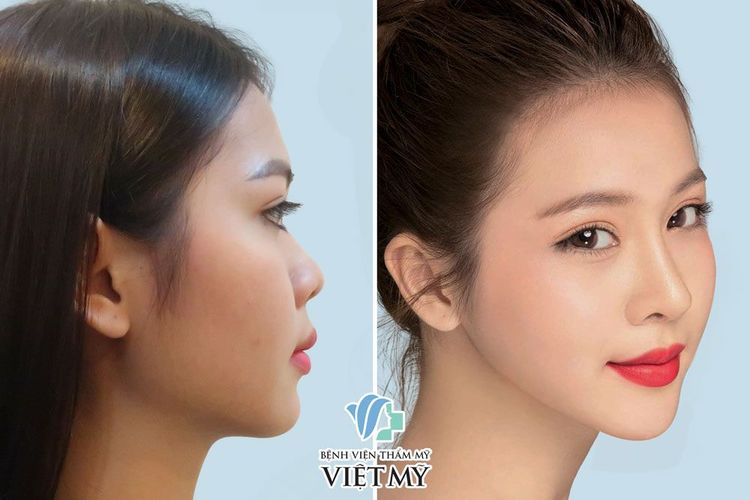
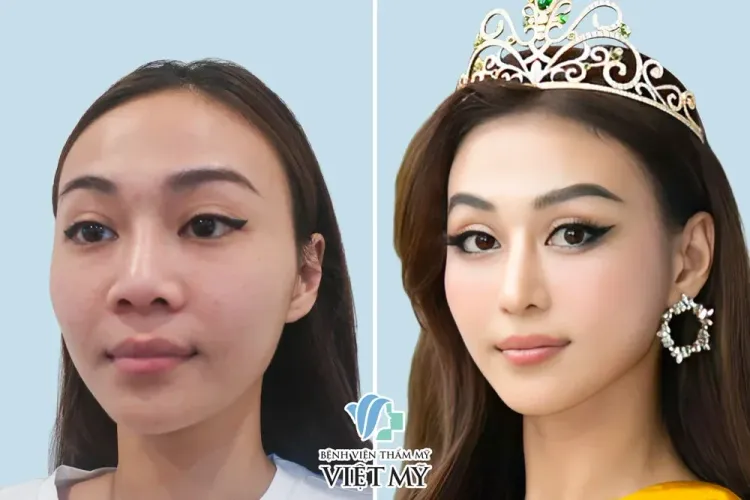


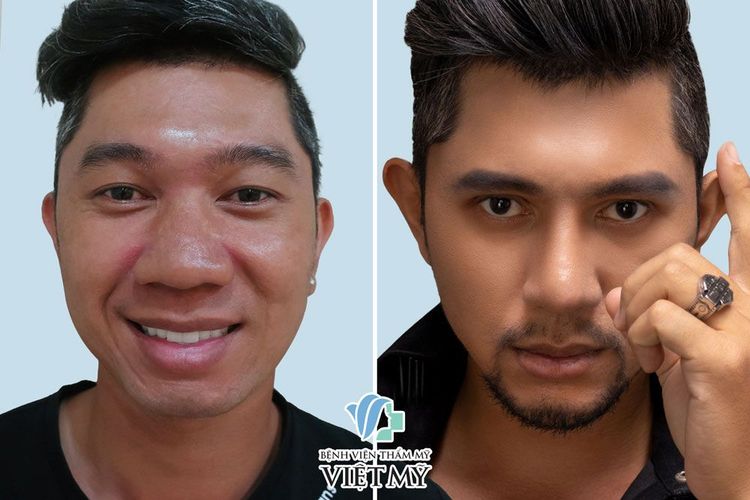
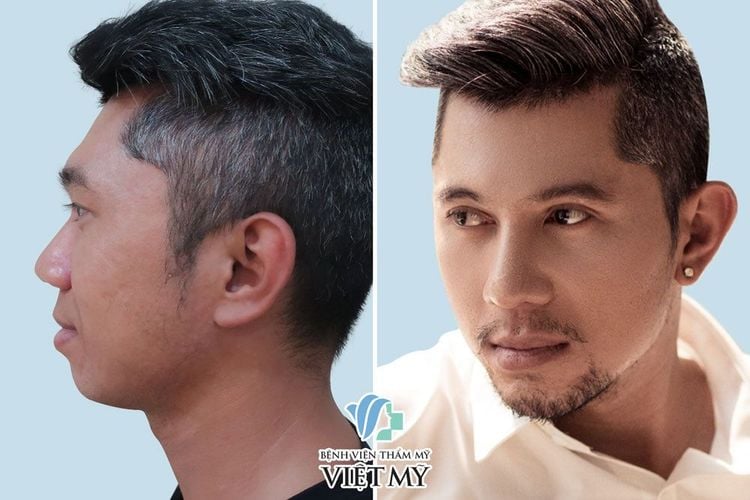

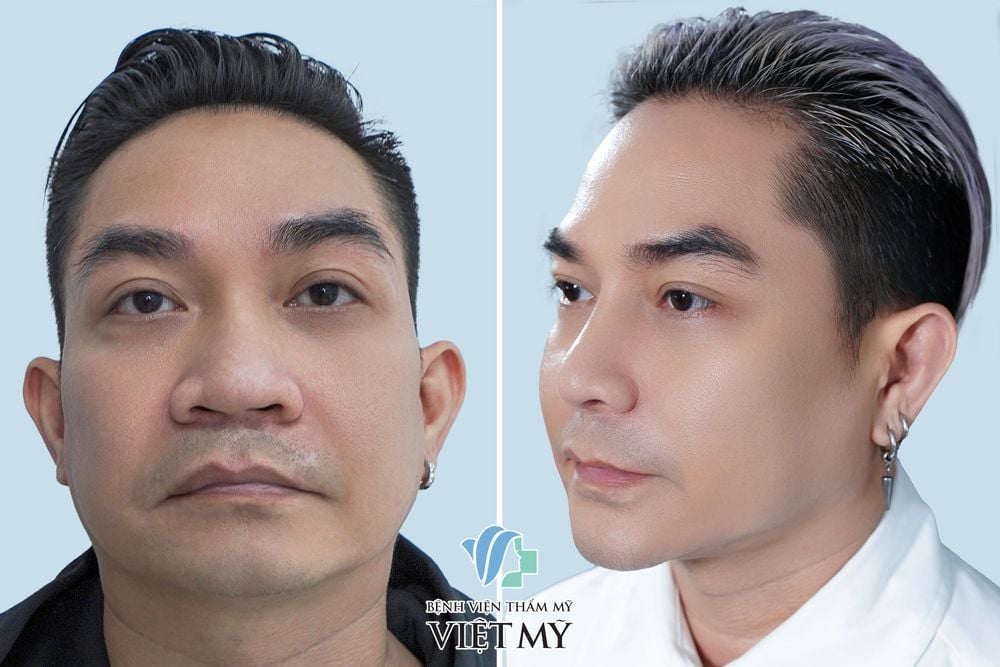
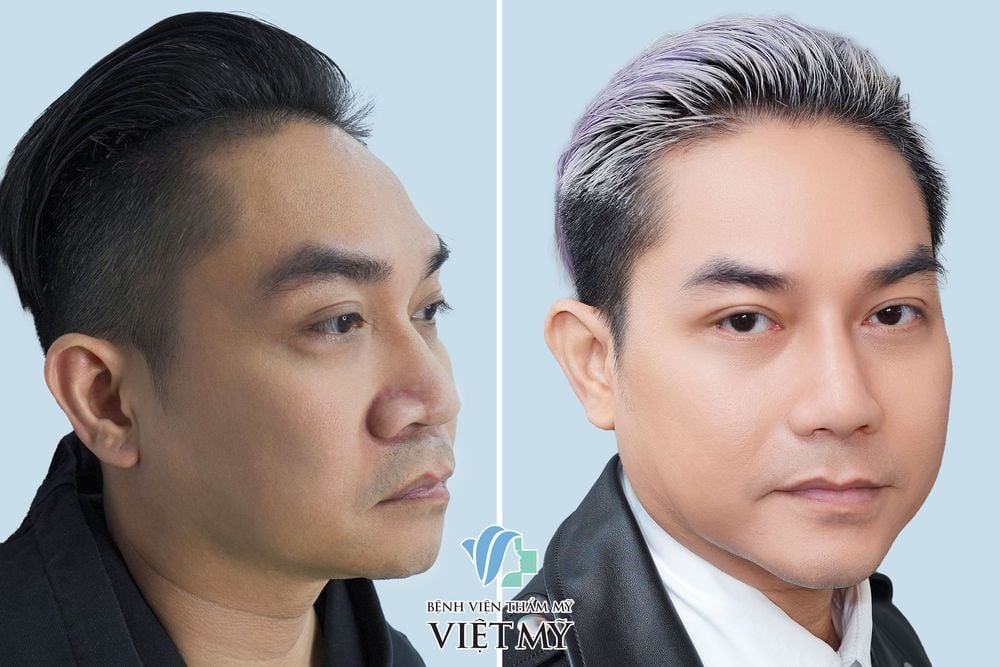
II. What is S-Line Korean Rhinoplasty?
There are various nose augmentation procedures, from non-surgical ones to fat grafting cartilage wrapping. Each method will vary with different prices. Everyone can have a look at the price chart to make the most suitable decision
After breast augmentation, S Line Korean Nose Lift is currently one of the most popular, helping ladies become more confident, attractive and enhance their outer beauty.
A beautifully ideal nose requires a perfect proportion where the length of the nose is ⅓ of the length of the face, the width of the nostrils equals the gap between two eyes. The triangle angle should be between 95 to 105 degrees, and the nose tip needs to be a bit higher than the middle part. The shape of the nasal bridge from the forehead corner to the columella with an S-shape will create an ideal S Line Koreannose shape.
If ladies are still looking for a natural, reputable and safe nose augmentation location, come to Viet My Plastic Surgery Hospital and experience on-site Korean nose augmentation from the experts here.
1. Benefits of rhinoplasty
Does rhinoplasty have any effects? The answer is no. Rhinoplasty can make the nose look longer, higher bridge of the nose, thinner nose wings and tip, create a balanced equilateral shape of the nostrils. This helps the nose become taller, more elegant, and more beautiful than before.
Besides, rhinoplasty is also done with the aim to adjust congenital defects at the nose, repair fractured nasal bones due to accidents or better enhance respiratory issues.
About longevity, the effectiveness of the surgery depends on the method chosen by clients. Usually, S Line Korean nose augmentation using imported artificial cartilage combined with autologous ones will bring a beautiful nose shape, and maintain the results for a long time
2. The types of noses require nose augmentation surgery
- Short and low noses
- Large noses
- Crooked noses
- Snub noses
- Hooked noses
3. Materials used for augmentation in artificial cartilage rhinoplasty
Relatively popular material for artificial augmentations such as: Silicone, Surgiform cartilage, Gore-Tex, Siligore (or Goresili)...
3.1. Silicone
This nose augmentation material is suitable for individuals wishing to narrow their nose wings and have a naturally soft nasal bridge, while their real nose is low or both sides are asymmetrical, with excessive skin.
During nose augmentation, silicone nose implants are used safely and commonly for a long time, and remain a top choice for doctors at aesthetic specialized hospitals.
3.2. Surgiform
Surgiform is a high quality material preferred in rhinoplasty surgery, stood out with a special form containing miniature holes, to help ensure smooth blood flow process, Thanks to that, the ability to integrate with the nasal framework is enhanced, providing stability and a natural appearance of the nose.
Surgiform cartilage is made of 100% ePTFE, has been certified safe and effective by FDA,and therefore widely used in the medical field. Rhinoplasty using Surgiform method not only brings a natural beauty but also maintains the long-lasting results, minimizing the risks of side effects.
3.3. Gore- tex.
Gore-tex is a popular material used in rhinoplasty, especially preferred in South Korea. This material has the advantages of being soft, flexible, and porous, allowing it to quickly adapt with the body post-surgery. Gore-tex allows nasolabial tissues to develop naturally and remain firm over time, providing stability and a long-lasting natural nose shape.
4. Differences between Surgifrom, Gore-tex, ePTFE and Silicone rhinoplasty.
Advantages of Silicone: more flexible, make the nose shape look more natural.
Disadvantages: Difficult to take out after a while, the thickness of the material can shrink, which makes the nose lower compared to the beginning.
This material is suitable for individuals with excess skin but desired to have a natural beauty and slim nose wings.
Another material for rhinoplasty is e - PTFE, which has identical characteristics with Gore-tex, only different manufacturers.
5. Surgiform, Sili-gore or Silitex cartilage rhinoplasty
Nose job plays a crucial role in creating balance for the face, which is the key factor to provide a harmonized and perfect face.
Sili-gore is a nose augmentation material combined with a thin layer of Gore-tex on the silicone surface, very suitable with clients who have thin nose skin.
6. Autologous cartilage rhinoplasty
Nose tip reducing method mostly autologous cartilages such as rib, septal, ear cartilage, or temporal fascia, fat…, Which helps minimize unwanted risks such as incompatibility or the phenomenon of bridge of the nose exposure. Using autologous material will bring natural and perfect results for your nose, while ensuring absolute safety.
7. Comparison between rhinoplasty using Silicone cartilage and Surgiform Cartilage
Rhinoplasty using Surgiform cartilage has superior advantages for those with thin nasal skin, creating a more natural-looking nasal bridge compared to using Silicone cartilage. However, Silicone still has a lower allergy rate compared to Surgiform cartilage.
The detailed consultation between our clients and Aesthetic surgeon is very important before deciding to undergo rhinoplasty. The doctor will listen to your desired nose shape after the surgery is done, then proceed to measure the distance from the forehead to the nose, from the nose to chin to create balance for your face. In addition, the doctor will also evaluate aspects such as the excessiveness of nasal skin, the size of the nose tip, thinness of the nose bridge as well as the size of the nostrils to ensure the most beautiful and balanced nose for your face.
Dr. Chiem Quoc Thai will also explain in detail about anesthesia techniques and methods used during the surgery. All your concerns will be fully resolved. When the surgery is performed by a highly skilled and experienced doctor, the risks of complications are rare and only make up a small percentage.
However, risks such as infection, bleeding or body reaction to augmentation materials still potentially occur. Our sisters can lower these risks by strictly following the doctor’s instructions before and after undergoing surgery.
Image of a client before and after undergoing rhinoplasty
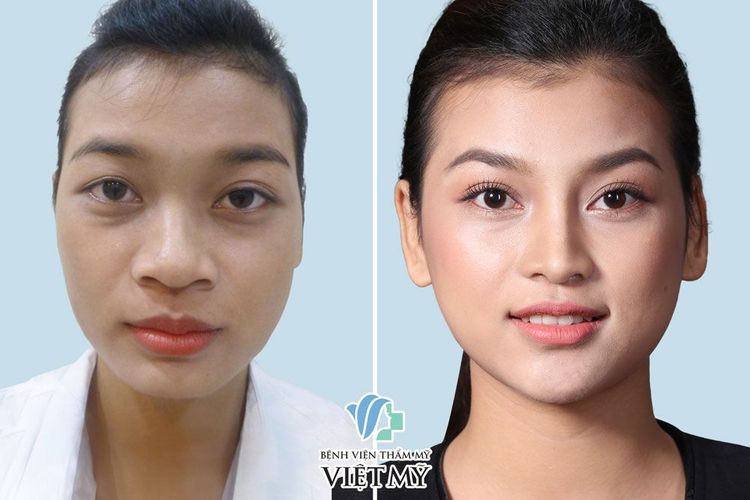
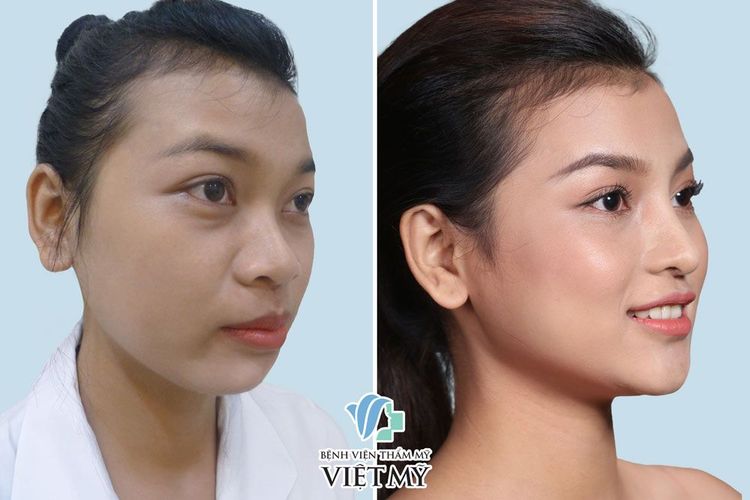




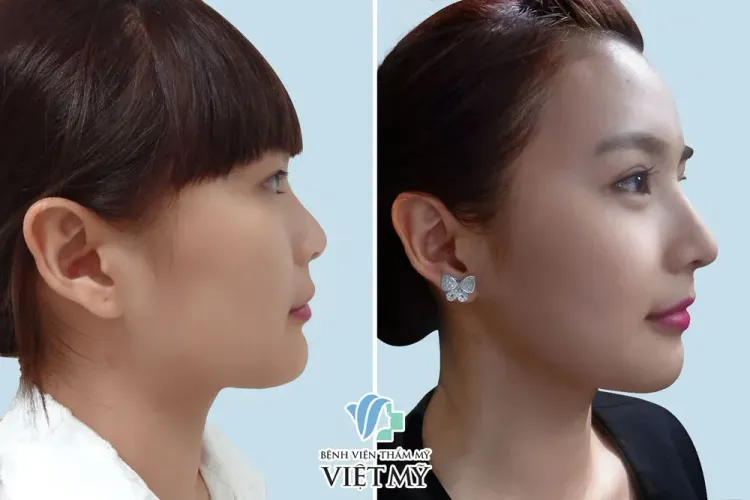
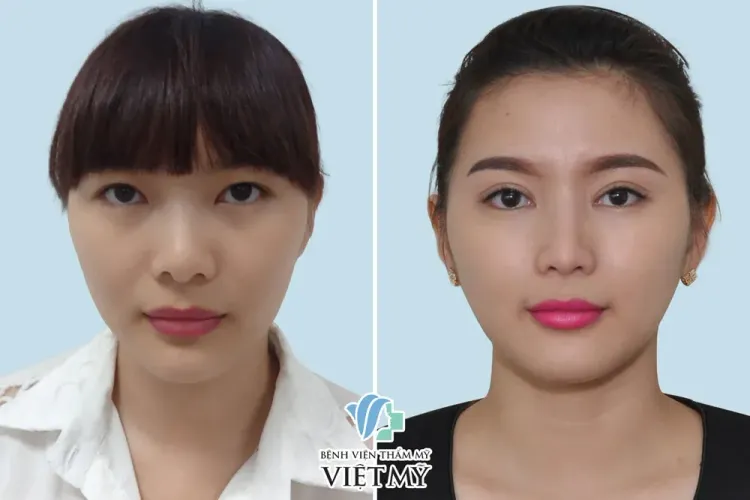
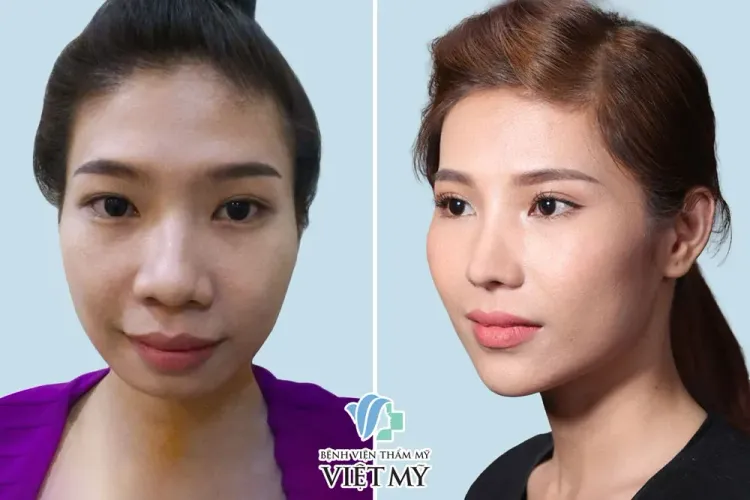
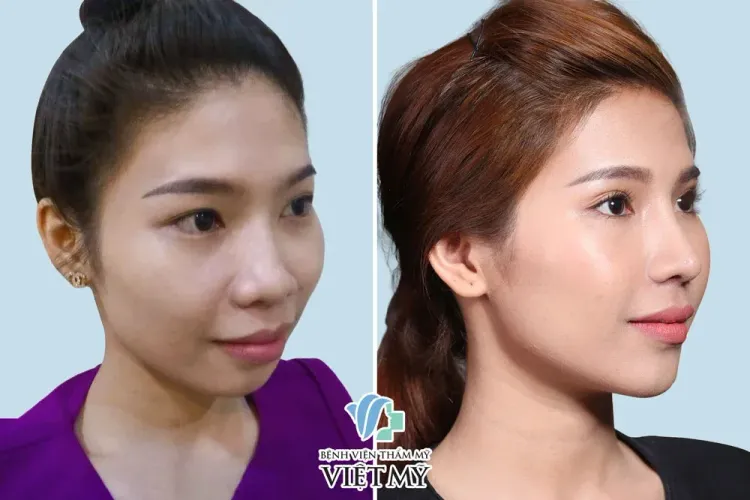
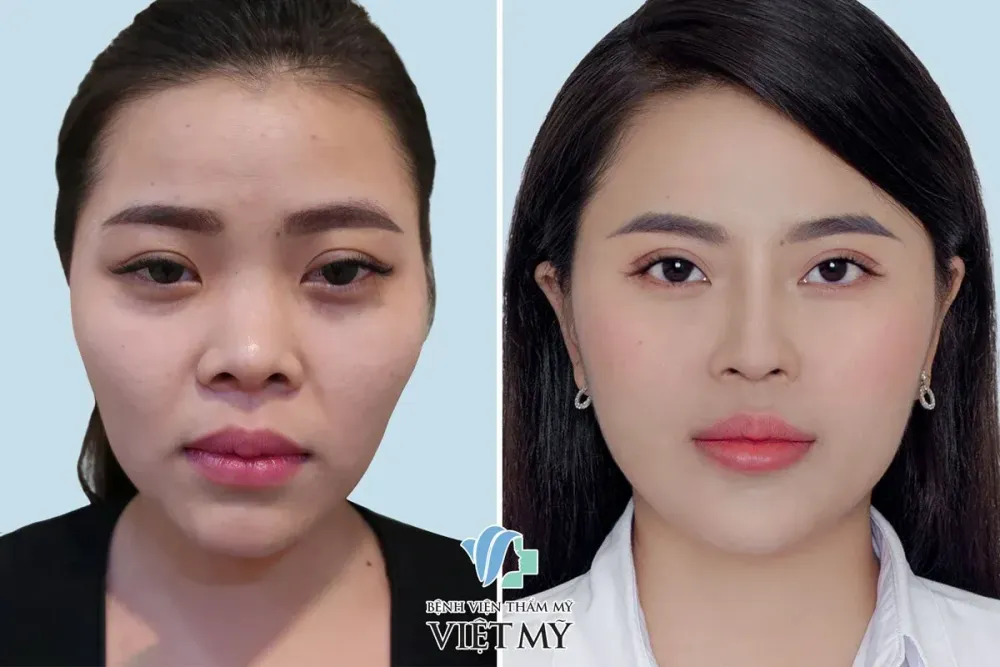
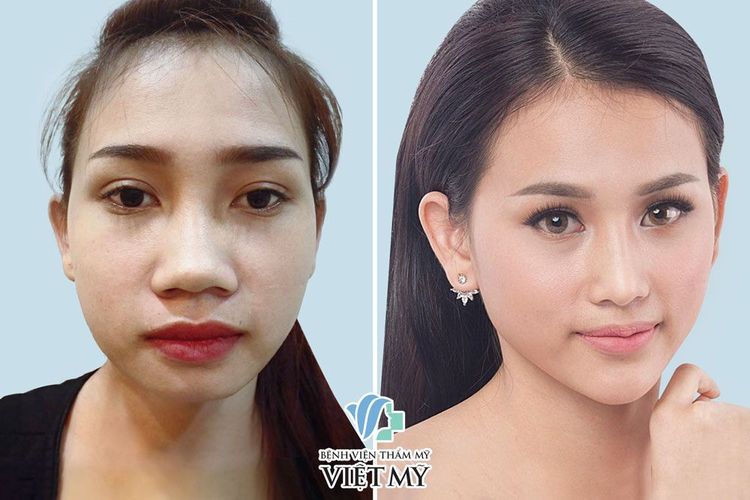
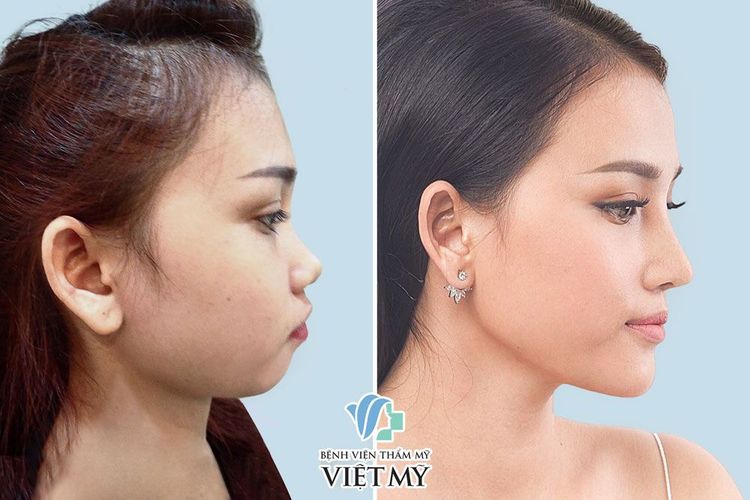
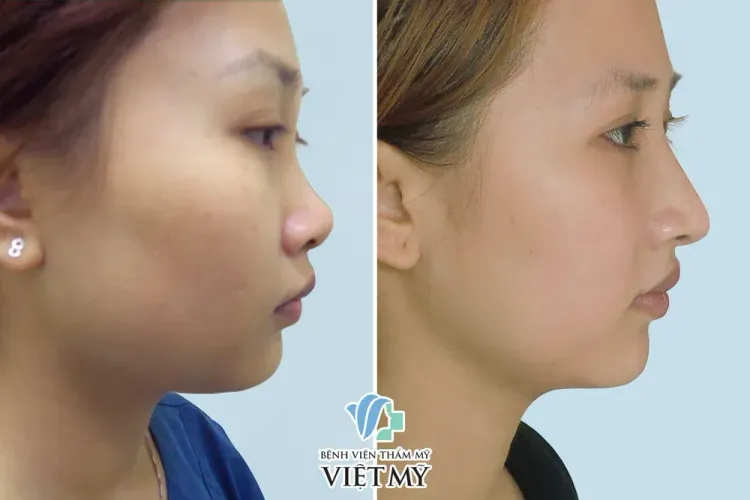
III. The process of rhinoplasty.
There are two techniques for rhinoplasty: closed rhinoplasty and open rhinoplasty. Closed rhinoplasty is usually implied to Korean Rhinoplasty or cartilage wrapping, while open rhinoplasty is often used for structural rhinoplasty.
1. Closed rhinoplasty technique
S-Line Rhinoplasty (using artificial cartilage) or cartilage wrapping rhinoplasty (combined between artificial cartilage and ear cartilage wrapping at the nose tip) only required to apply closed rhinoplasty techniques.
Applied to cases of rhinoplasty using artificial cartilage or nose tip cartilage wrapping.
Is S-Line rhinoplasty (artificial cartilage) or nose tip cartilage wrapping painful, or complicated? With local anesthesia, it is painless. The process of rhinoplasty usually lasts from 15 to 20 minutes. But for complicated cases, it may take longer.
During rhinoplasty, the surgeon will make a small incision at about 1 cm inside your nose, then separate the nose skin from the bone and cartilage. The artificial cartilage will be inserted to shape the desired nose. The naturality of the nose shape after surgery depends on the structure of the nose pre-surgery as well as the skills and techniques of the surgeon. In the case of nose tip cartilage wrapping, the surgeon will extract the ear cartilage to wrap the artificial cartilage tip to avoid redness or sharpness of the tip, which is often seen when artificial cartilage is used.
The advantages of close rhinoplasty (using artificial cartilage or cartilage wrapping) is the low prices and simple procedure.
Drawbacks: This procedure mostly enhances the bridge of the nose, but is unable to extend the nose tip. Over time, there may be a condition of visible nasal bridge, especially a pointed and red tip of the nose if only using artificial cartilage without covering the bridge. In addition, there is a short percentage of allergies or infections due to the body not being compatible with the augmentation material.
2. Open rhinoplasty techniques using structural rhinoplasty.
Open nose shaping techniques using ear cartilage, rib cartilage or septal cartilage to shape ⅓ of the tip of the nose, while the remaining ⅔ of the nose will be enhanced using artificial cartilage ( such as silicone or surgiform). This procedure is called structural rhinoplasty combined with using artificial cartilage, also known as partial structural rhinoplasty
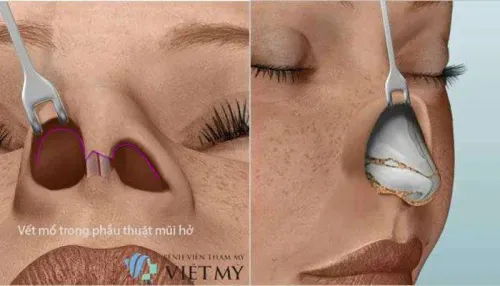
This method is usually applied to shaping the tip of the nose using autologous cartilage, which is the most advanced technique to create a beautiful and perfect nose, usually known as structural rhinoplasty, ear cartilage rhinoplasty, or rib cartilage rhinoplasty.
3. Painless structural rhinoplasty : local anesthesia or full anesthesia
This surgery procedure usually lasts from 60 to 90 minutes. The surgeon will make a wing-shaped incision on the columells, then use autologous cartilage (ear cartilage, rib cartilage, septal cartilage) to shape the tip of the nose.
In the case the bridge of the nose is hunched, the surgeon will grind the hunch using a specialized tool to sculpt the nasal bone, while compressing the bone on both sides to make the nose bridge slimmer and more elegant. The ear cartilage or rib cartilage will also be adjusted and trimmed to fit the shape of the nose tip. Finally, the artificial cartilage will be inserted to enhance ⅔ of the nose bridge.
The advantages of open rhinoplasty (structural) is shaping a long, exquisite nose shape without being red or exposing the sharp bridge at the tip.
Drawbacks: high prices, complicated procedures. In addition, if the bridge uses artificial cartilage, there are still risks of allergies or infections due to the body not being compatible with strange materials.
4. What is full rib cartilage rhinoplasty (full structural rib cartilage)?
It means the entire nose (the bridge, tip, and columells) will be completely reshaped by the surgeon using autologous rib cartilage.
Firstly, the surgeon will extract the rib cartilage of the patient and divide it into two parts. One part will be used to shape the tip of the nose, making it higher and longer (especially in the case of a short tip of the nose). The other part will be sculpted to shape the bridge of the nose. This method is also known as full structural rib cartilage rhinoplasty.
Advantages: for people allergic with artificial cartilages, rhinoplasty using full rib cartilage is the most effective solution to avoid risks of allergies.
Drawbacks: Due to the complex techniques, this procedure costs more compared to structural rhinoplasty combined with artificial cartilage.
5. What is a beautiful men’s nose? And is rhinoplasty for men harder than for women?
- Men’s nose on the side is usually more straight compared to women’s
- When performing rhinoplasty for men, the triangular between the nose tip and the upper lip usually lies between 90-95 degrees
- Men’s noses should be much larger and longer to create a masculine appearance.
- Both the nasal and the tip of men are usually larger compared to those of women.
6. Post-operative treatment.
A small bandage will be applied to the tip of the nose, and a flexible plastic piece will be used to stabilize the nose and the cartilage, helping to shape a more beautiful and precise nose shape.
In the first 24 hours after rhinoplasty, the nose might have moderate swelling and pain. Ladies can apply pain relievers based on the doctor’s prescription to reduce the condition. Rest well on the bed with your head held high (except going to the bathroom) on the first day after undergoing open rhinoplasty.
The eyes surrounding areas will be swollen and bruised on the following day. Compressing ice bags on the first two days will help reduce the bruises and feel more comfortable. In fact, rhinoplasty doesn’t cause much pain as you might have worried about before. The swellings and bruises will gradually fade, and disappear after 5 to 10 days.
S-Line Korean Rhinoplasty is a popular aesthetic procedure, which helps elevate a refined and natural nose shape that fits the Asian facial shape. Before deciding to undergo the procedure, it is essential to fully understand the process, techniques, as well as choosing a safe and reputable facility to ensure the safe and satisfactory results. With the consultation and advice from the experts, ladies will be more confident when choosing the suitable cosmetic procedure, which helps elevate your natural beauty.
* The results achieved depend on each individual’s constitutions







